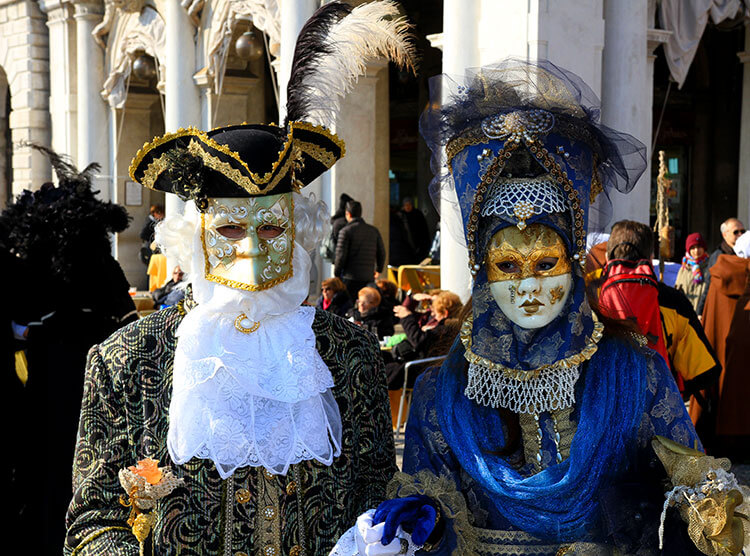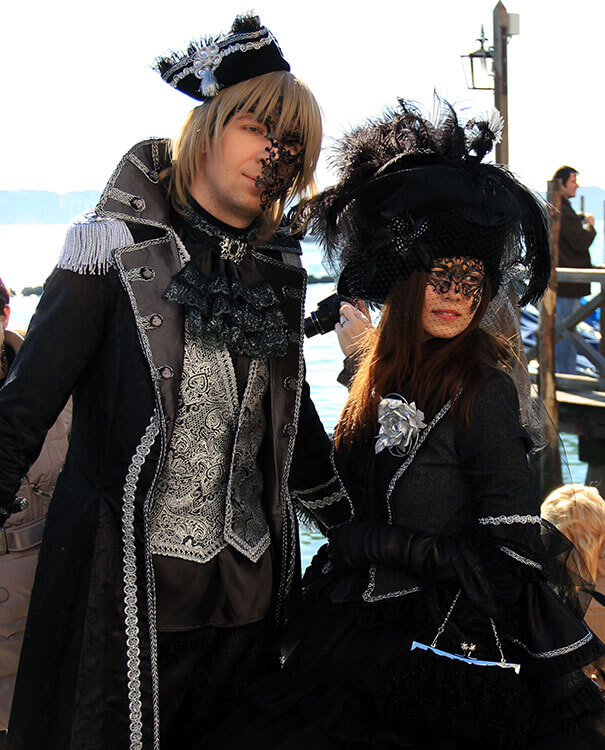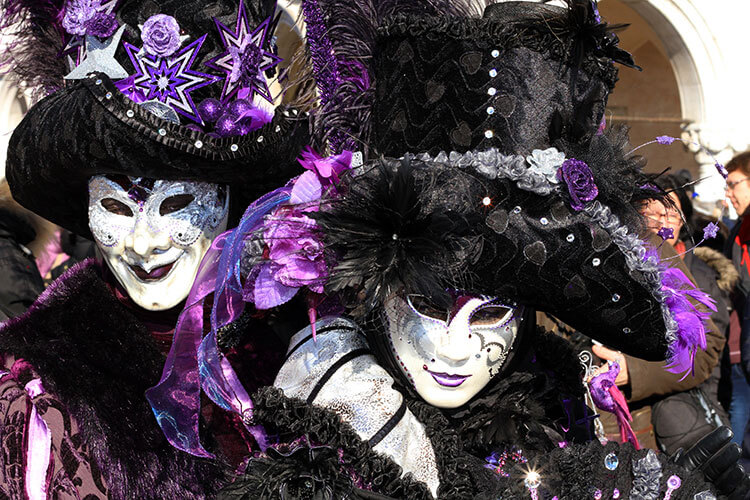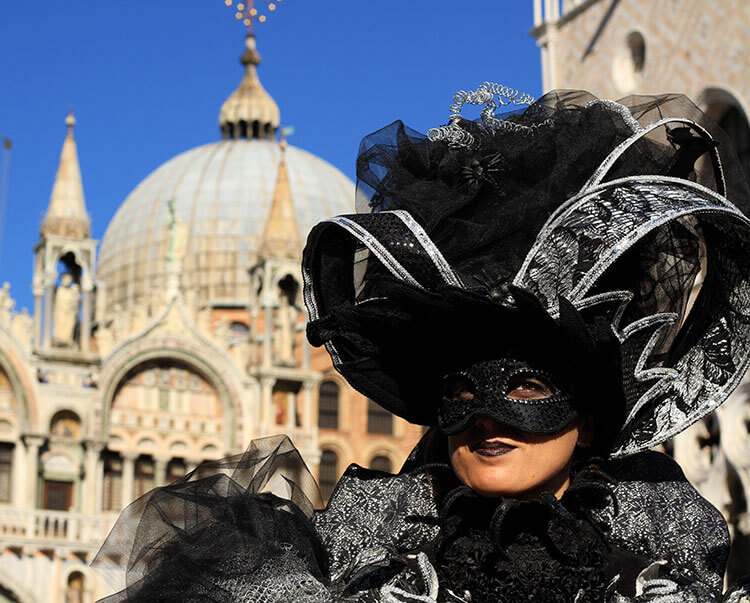Venice Carnival is a centuries old tradition and one of the world’s most famous carnivals. The Carnival of Venice also became our own tradition during the seven years that we called Italy home, masquerading each year in La Serenissima with the locals and tourists alike. The costumes, events and parties over the 10 days leading up to Fat Tuesday make Venice Carnival one of the biggest events in Italy, but it’s the masks – the quintessential feature – that makes the Carnival of Venice unique from Italy’s other famous carnivals.
The tradition of the mask started in the 13th century when Venetians would hold celebrations and parties from December 26th until the start of Lent and wear elaborate masks to conceal their identity. These parties were the only time when the lower and upper classes mingled together. Aristocrats and peasants, disguised by their masks, played out their fantasies together. They indulged in illicit activities like gambling, clandestine affairs, political assassination, and dancing and partying the night away.
Early Venetian masks were quite simple, and after Venice Carnival was abolished for nearly two centuries, served a very practical purpose. Women were not allowed to go to the theater without wearing a bauta to cover their faces. Nowadays, Venetian masks are a much more elaborate affair. They are made with the application of gesso, a white paint mixture, and gold leaf and are all hand-painted using natural feathers and gems to decorate. There are a few typically Venetian masks.

Typical Venetian Carnival Masks

Bauta
Considered to be the traditional Venetian mask, bauta comes from the German “behüten“, meaning to protect. It has always been a popular mask because it is mostly covers the facial features, which allowed people to conceal both their identity and social class. The bauta also allows the wearer to easily eat and drink, which is probably another reason why it has long been the popular Venetian mask style. It is always worn with the black hat with three tips (tricorno).
The bauta is also popular as a souvenir, because the Venetian mask can stand upright on its own thanks to its shape. It’s a great choice if you want to display a Venetian mask on a table or in a cabinet at home.
Moretta
Invented in France, the moretta mask was quickly adopted by Venetian women because of the way it accentuated their feminine features. The moretta mask was actually first worn by women visiting convents and secured by clenching a button between their teeth. This ensured their vow of silence in the convent. Modern moretta masks are much more comfortable and simply tie on.
Volto
The volto mask is also called the larva mask, meaning ghost-like appearance since the volto mask is always white. It was quite comfortable to wear and allowed the wearer to eat and drink easily, since the original volto mask did not cover the entire face like today’s modern versions. It was worn by both men and women with a black cloak and the black tricorno hat.
If you want to purchase a Venetian mask as a souvenir and you want one that you can hang on a wall, the volto mask is a great selection. The shape easily lets the mask hang flat against a wall.
Columbina
One of the first actresses in the Commedia dell’arte felt her face was much to beautiful to cover completely, and so instead wore a half-mask especially designed for her. The mask type quickly became popular and nowadays is highly decorated with gold, silver, crystal, and feathers.
The columbina mask is a very popular choice for wearing to masquerade balls since the shape allows you to eat and drink easily without removing the mask.
Medico della Peste (Plague Doctor)
The birdlike mask actually was not worn by carnival goers; instead it originated in the 17th century by French physician Charles de Lorme and was worn by plague doctors to protect them from airborne diseases. Carnival goers eventually started wearing a decorated version as a memento mori, a remembrance of their mortality.









Teresa Roberts says
Amazing festivities and mind-blowing costumes to boot. I have seen my fair share of festivals, including Semana Santa in Spain and Guatemala, patron saint day in San Miguel de Allende and more. Such fun!
Andi Perullo de Ledesma says
They are just soooo gorgeous!
Jennifer says
Seeing the costumes and elaborate masks is my favorite part of Carnevale!
Andrew says
Neat. I didn’t realize they all had names. We went to Carnevale last year. It is a sight to see, but SO many people.
Jennifer Dombrowski says
Yes, Carnevale is packed and can feel like you are being herded like cattle. But it’s worth it to deal with the crowd once per year to see the striking costumes!
Leyla Giray Alyanak says
What a great story, fascinating! Funny I was just yesterday looking at a painting of one of those bird masks designed to keep away the plague… and the photos – wonderful!
Jennifer says
Thanks, Leyla! We've written about the history of Carnevale itself before (twice) so we thought it would be interesting to write about the masks. They are such an integral part of Carnevale and not many people know the significance of the masks.
D.J. says
Cool story J…I’ve always wanted to go to a masquerade party:)
Andrea says
These are so incredible! I love noticing all the differences between all the different carnivals around the world
Jennifer Dombrowski says
I would love to attend some more carnivals around the world! Have you been to any?
Dustin Main says
I dig the pics, particularly the first two. Would have been a blast to shoot.
Thanks for the back stories as well. Mask culture has always been fascinating to me.
Jennifer Dombrowski says
Carnevale is a lot of fun trying to guess who might be behind the mask! I’d love to attend more carnivals around the world.
George says
Very authentic and original post.Makes you feel hungry for a journey!
Angela says
Such a fascinating post!
Jennifer Dombrowski says
Thanks, Angela! I’m glad that you enjoyed a bit of the history behind Carnevale masks.
Noman says
Hi, nice to see you and its the nice information for the carnival. Did you ever joined the carnival at Brazil.
Rgds,
Noman.
Jennifer Dombrowski says
Glad you enjoyed the history of the masks, Norman! No, we’ve not been to carnival in Brazil. It does look like fun though!
Veronica says
We haven’t been to Venice during the celebrations, but LOVE the shops that sell the masks and costumes. Sparked my dreaming of the real thing – must be magical to see it come alive! Your photos are fantastic! -Veronica
Victor Tribunsky says
Great story, Jennifer.
We go to Venice in three weeks, and we have the costumes 🙂 It will be funny.
Jennifer Dombrowski says
Fun! What are you dressing up as Victor? We’ll of course be there!
Devlin says
Very fascinating, though I can’t help but to be reminded of Eyes Wide Shut haha.
Jennifer Dombrowski says
Haha! True Devlin. A mask maker in Venice made the masks for the film.
Janice says
Fun post – and gorgeous carnival mask pics! How special to visit Venice during its Carnival!
Jennifer Dombrowski says
We actually live about 45 minutes away from Venice so we’ve been the last five years now. I think we’re skipping this year though.
Laura says
Great photos! When we visited Venice, we got to go to one of the few shops that still makes masks by hand — fascinating!
Jennifer Dombrowski says
Awesome Laura! There’s some shops that even offer mask making workshops. I’d like to make my own before I move from Italy.
Lori says
I was curious to know more about this carnival several years ago 🙂 I am glad to see this post with info on the Venice Carnival Mask – and its history! Great photos too!
carol a clark says
Great pictures and stories about the masks. I learned a lot about them. bought two small ones for my fridge while on vacation in Venice and wasn’t sure about their beginning now I am. thank you.
Jennifer Dombrowski says
Hope you enjoyed your visit to Venice, Carol!